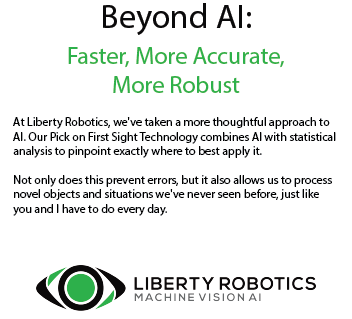 By definition, the future is unexpected. We cannot know for sure what’s going to happen tomorrow, in two days, or even two minutes.
By definition, the future is unexpected. We cannot know for sure what’s going to happen tomorrow, in two days, or even two minutes.
Buddhism teaches us that it is reasonable to expect that unexpected things will happen, and sometimes, some of those things will be undesirable.
So why do we see so many box packing patents based on advanced planning, uniform parcels, and packing manifests?
These systems hinge on nothing going wrong, and when mistakes do inevitably happen, the AI models they use are so large that the errors often can’t be found.
At Liberty Robotics, we’ve taken a more thoughtful approach to AI. Our Pick on First Sight Technology combines AI with statistical analysis to pinpoint exactly where and how to best apply that AI.
This guided approach not only prevents errors but also allows us to process novel objects and situations we’ve never seen before, just like you and I have to do every day in life.
So how do we maintain the robust reliability of our system without an over-reliance on pre-planning? There are 3 things that we do:
1. Information Theory: We get enhanced data through the merging of appearance and depth data, using information theoretic surprisal. See our patent at www.ppubs.uspto.gov/20230120703, if you’re curious.
2. Look Ahead Algorithms: When deciding where to place parcels, we use specialized algorithms that map out possible futures. Now, this may seem like an obvious thing to do, but most other companies don’t. They don’t because they can’t.
This is a non-polynomial hard problem. The short version of what that means is the deeper you look into the problem, the more time you need to derive a workable solution. If there are 3 boxes to place in an empty container, there are approximately 256,000,000,000,000 solutions as to where to place them. (For you math folks, if N = 3, then 2^(3*16) = 2^48.)
We use proprietary algorithms processed by GPUs to prune the search tree, in order to overcome this challenge.
3. Justified Heuristics: A heuristic is a rule of thumb, and in the case of our algorithms, we justify our rules of thumb via offline simulation. This allows us to optimize the statistical weights we use to make decisions. We run 100,000 to 1,000,000 simulations to decide those weights, per situation.
Again, all of this is possible because of our unique approach of applying human intelligence to AI models. We’ve tested our approach against deep learning AI models, such as SAM (Segment Anything Models), and have proven that for every 1 in 100 errors a SAM model will have, ours will have 1 in 10,000.
The Second Noble Truth of Buddhism is that we suffer because we are attached to specific outcomes. For better or worse though, logistics and manufacturing are all about attaining specific outcomes. AI can aid us in reaching those goals, in that it excels at calculating known quantities.
Where it falls short though is in the realm of actual thought. For instance, if the largest percentage of stable box placements happen to be blue, AI may erroneously conclude that all blue boxes are stable. This is called over-training.
Human intelligence, on the other hand, excels at dealing with novel situations and solving unexpected problems. By strategically combining both in our algorithms, Liberty Robotics creates a whole that is greater than the sum of both parts alone.
Our Pick on First Sight Technology can deal with the unexpected situations that arise in harsh factory and warehouse environments, while still maintaining the most robust system reliability on the market.
